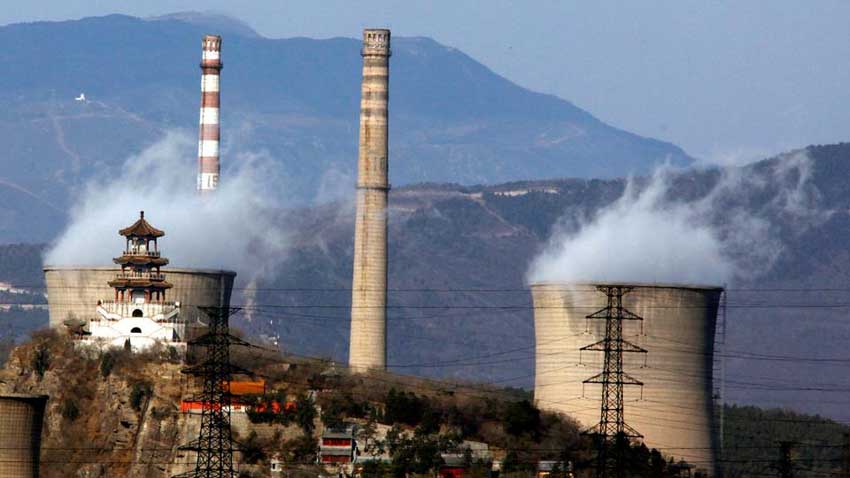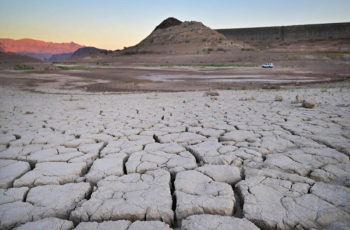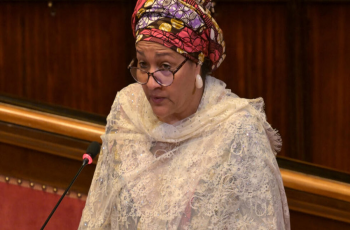China Aims To Be Carbon Neutral By 2060. Its New 5-Year Plan Won’t Cut It.
The plan could allow for emissions to keep growing through 2025.

Photo: TYT
0n Friday, China released a draft summary of its 14th Five-Year Plan, the all-important document that not only guides the country’s economic development but also has huge consequences for global carbon dioxide emissions and climate change.
The new plan’s 2025 emissions goals reflect an ongoing contradiction between China’s short-term and long-term climate goals.
In the long run, China has expressed a strong commitment to climate action. President Xi Jinping surprised the world last September when he announced that China would aim to reach carbon neutrality by 2060. Climate scientists have called for countries to hit that goal by 2050, but it was still a significant step forward for China — the first time the country made any formal commitment to zeroing out its emissions.
And yet, even as Xi made that announcement, CO2 emissions in China were soaring. Like the rest of the world, the pandemic had initially caused economic activity to plummet in China in early 2020. But after swiftly bringing the pandemic under control within its borders, the Chinese government funneled stimulus dollars into the heavily polluting construction and manufacturing sectors, stoking steel and cement production. As a result, China’s emissions rose an estimated 1.5 percent in 2020, even accounting for the initial drop.
“China’s economic recovery from the pandemic so far has been anything but green,” Li Shuo, a senior global policy adviser for Greenpeace East Asia, said during a press conference on Monday.
Now, with the release of the 14th Five-Year Plan targets, the Chinese government is signaling that the country’s emissions growth will likely slow slightly from recent months, but continue for at least the next five years, according to analysts.
On the one hand, the growing emphasis on green development in China’s plans, rather than the historical single-minded focus on GDP, shows that the Communist Party sees a strong national interest in reducing emissions over time. However, these latest climate targets do not rise to the level the global scientific consensus calls for.
Let’s look at where China should be by 2025 to be in line with the Paris agreement goals — and the reasons it is still dragging its feet on climate action.
The shortfall in the 14th Five-Year Plan’s climate ambition
The 14th Five-Year Plan contains a number of key climate goals that will guide the country over the coming years. Together, these targets suggest China will continue to pursue climate action, but they don’t amount to a new era of grand aspirations.
“As the first five-year plan after China committed to reach carbon neutrality by 2060, the 14th FYP was expected to demonstrate strong climate ambition. However, the draft plan presented today does not seem to meet the expectations,” said Zhang Shuwei, a chief economist at Draworld Environment Research Center, a Beijing-based consultancy firm. “The international community expected China’s climate policy to ‘jump,’ but in reality it is still ‘crawling.’”
Prominent Chinese climate advocates had hoped that the plan might clarify when exactly China plans to peak its carbon emissions, and at what level, by setting a “carbon cap.” Instead, the plan uses a more convoluted metric included in previous plans — the reduction of “carbon intensity,” which is carbon emissions per unit of GDP. This target was set at 18 percent, the same as the previous five-year plan.
Typically, the government also sets an annual GDP growth target for the five-year period, which can be used to back-calculate absolute emissions growth. But this year, likely due to ongoing uncertainties related to the global economic recovery from the pandemic, China only set a one-year goal for GDP to grow over 6 percent.
Combined, these two targets suggest China’s emissions will continue to rise this coming year, by at least 1.9 percent. If GDP grows by at least 3.9 percent annually in the following four years, China’s emissions can continue to increase at a slow rate while still meeting the new carbon intensity reduction target, Zhang calculated.
In the worst-case scenario, if China continues its energy-intensive recovery from the pandemic and GDP growth shoots up for several years, emissions growth could even accelerate after slowing down over the previous five years, according to Lauri Myllyvirta, lead analyst at the Center for Research on Energy and Clean Air (CREA), an international environmental think tank. (China’s carbon emissions grew by an estimated 1.7 percent annually over the past five-year period.)
He also noted that one of China’s other key climate targets, a cap on overall energy consumption, wasn’t included in this latest plan, removing a guardrail on emissions growth.
What does this mean for global climate goals? According to a joint study published by the Asia Society Policy Institute and Climate Analytics in November, China needs to peak its emissions as soon as possible, and certainly by 2025, to be in line with the Paris agreement. Currently, China has only committed to peaking its emissions before 2030.
The other main climate target from the 14th Five-Year Plan is slightly more hopeful. China has set a slightly bolder renewable energy goal: 20 percent of its energy should come from non-fossil sources by 2025. This is a slight acceleration over the non-fossil energy buildout in the last five-year plan period, during which the share rose from 12.3 to 15.9 percent.
However, once again, it doesn’t fully align with China’s long-term climate goals and the Paris agreement. According to analysis from CREA, China needs to get 25 percent of its energy from non-fossil sources by 2025 to be on a straight path to meeting its 2060 goal.
So on the whole, these targets suggest modest progress from the world’s top emitter in the years to come. It is worth noting, though, that historically, environmental goals in five-year plans have been set to be overachieved. All of the climate targets in the 13th Five-Year Plan were surpassed.
“Considering China’s habit of under-committing and over-delivering five-year plans, these targets will hopefully hedge against a surge in further emission growth,” said Greenpeace East Asia’s Li. “But to tackle the climate crisis, China needs to bring its emission growth to a much slower level, and to flatten the emission curve early in the upcoming five-year period.”
China will face further tests of its climate ambition this year
Although the 14th Five-Year Plan is an important gauge of China’s commitment to tackling climate change in the near-term, the country’s intentions will be further clarified in the months ahead.
As is typical, by the end of the year China will also release specific five-year plans for energy and electricity — and, for the first time, the Ministry of Ecology and Environment will publish a climate five-year plan and an emissions-peaking plan. Those plans will provide more granular detail on some of the major outstanding issues that will dictate China’s emissions.
The biggest question remains whether China will reverse its coal consumption, which increased slightly last year even during the pandemic. Environmentalists grew increasingly concerned as China built 38.4 gigawatts of new coal-fired power plant capacity in 2020 alone — three-quarters of new coal construction globally.
What happens internationally may also play a role in shaping China’s emissions. The Biden administration has pledged to reassert US global leadership on climate change and is planning to host a global climate summit on Earth Day in April. In the lead-up, the administration has said it will release a new, more ambitious 2030 target for the US.
That could potentially free up China to also increase its 2030 goals. In December, President Xi announced new targets, which experts said were not strong enough. However, they have not been formalized under the Paris agreement yet, so there is still room for China to make its targets more aggressive by the deadline: the next big round of UN climate negotiations to be held in November in Glasgow, Scotland.
But with the ongoing tensions in US-China relations, analysts are uncertain how closely the two countries will be able to cooperate on climate change.
For now, the 14th Five-Year Plan has shown that China is not yet ready to set its sights much higher on climate change in the near term.
“It opened up a battle between these two sides of the aisle,” Li said, pointing to the division between advocates for continued industrial growth and those fighting for climate progress in China. “In a way, instead of answering the key climate-related questions, this morning raised more questions.”
-

Moldovan youth is more than ready to join the EU
2024-04-18 -

UN says solutions exist to rapidly ease debt burden of poor nations
2024-04-18 -

'Human-induced' climate change behind deadly Sahel heatwave: study
2024-04-18 -

Climate impacts set to cut 2050 global GDP by nearly a fifth
2024-04-18 -

US sterilizations spiked after national right to abortion overturned: study
2024-04-13 -

Future of Africa's flamingos threatened by rising lakes: study
2024-04-13 -

Corporate climate pledge weakened by carbon offsets move
2024-04-11 -

Humanity lost 'moral compass' on Gaza: top UN official
2024-04-10 -

No.1 Scheffler says patience and trust are secrets to success
2024-04-10 -

From homeless addict to city chief: the unusual journey of Canadian mayor
2024-04-10
